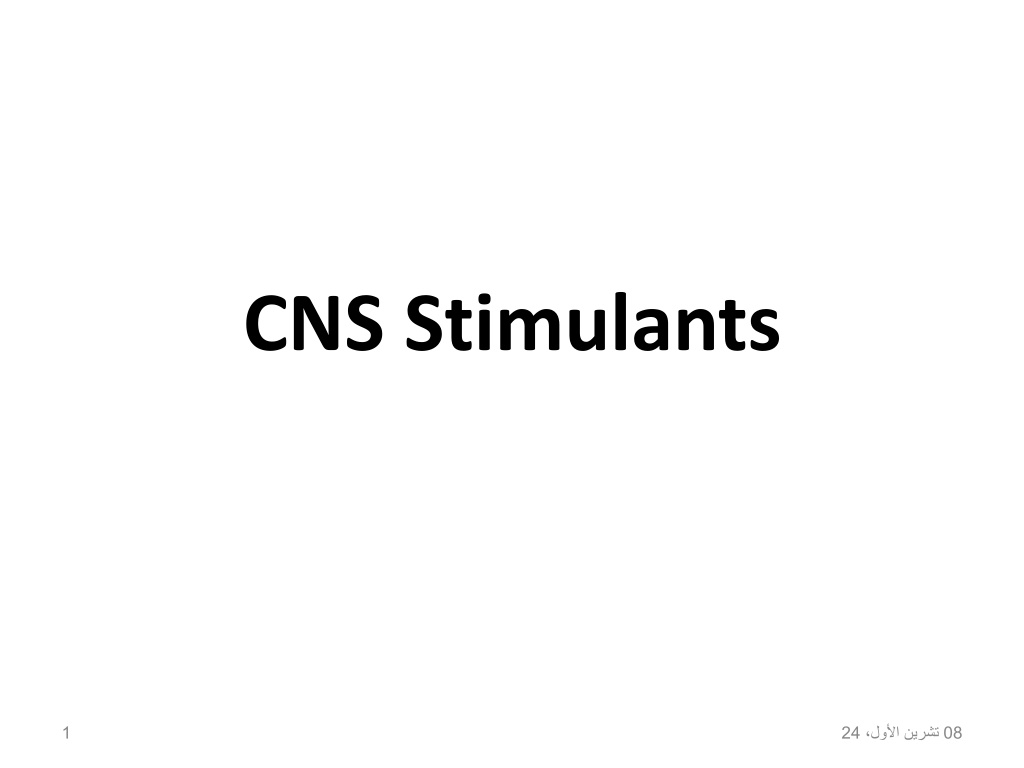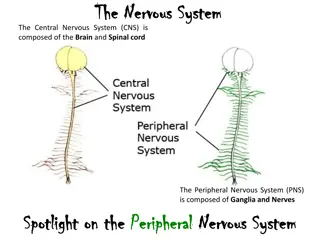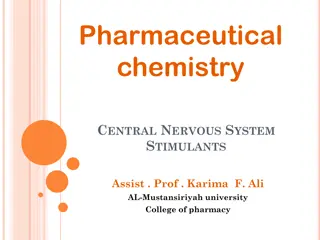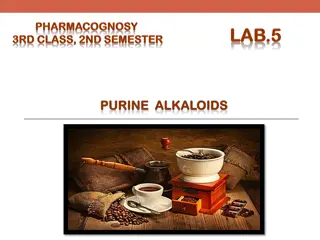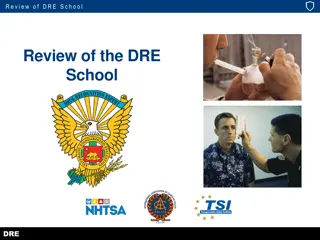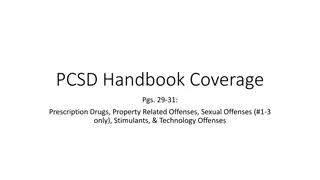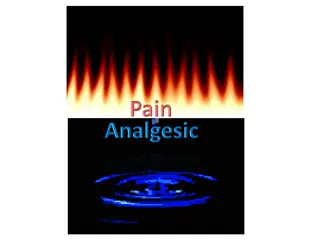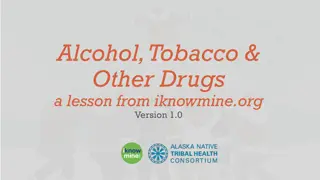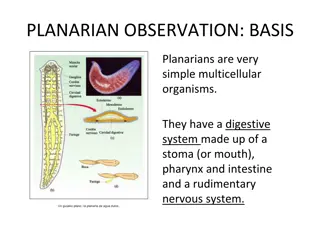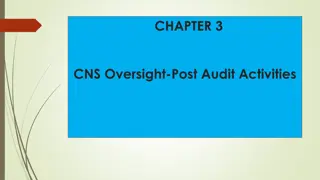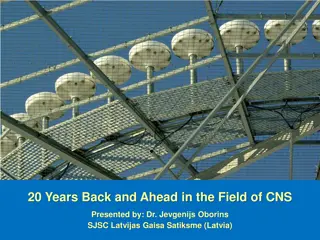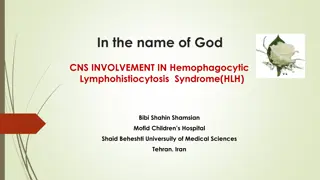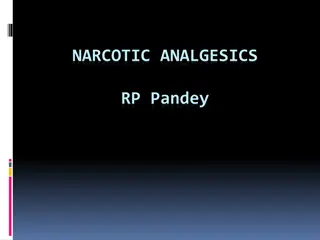Overview of CNS Stimulants and Their Effects on the Body
CNS stimulants are drugs that primarily act on the central nervous system, with two main groups being psychomotor stimulants and hallucinogens. Common examples include caffeine, theophylline, and nicotine. These stimulants can have various effects on the body, such as increasing alertness, heart rate, and diuretic action. However, they also carry risks of adverse effects like insomnia, anxiety, and dependency. Understanding the mechanisms of action and therapeutic uses of these stimulants is crucial for their safe and effective management.
Download Presentation

Please find below an Image/Link to download the presentation.
The content on the website is provided AS IS for your information and personal use only. It may not be sold, licensed, or shared on other websites without obtaining consent from the author.If you encounter any issues during the download, it is possible that the publisher has removed the file from their server.
You are allowed to download the files provided on this website for personal or commercial use, subject to the condition that they are used lawfully. All files are the property of their respective owners.
The content on the website is provided AS IS for your information and personal use only. It may not be sold, licensed, or shared on other websites without obtaining consent from the author.
E N D
Presentation Transcript
CNS Stimulants 1 24 08
CNS stimulants: drugs that act primarily to stimulate the central nervous system (CNS) are two groups : 1. Psychomotor stimulants: stimulants cause excitement and euphoria, decrease feelings of fatigue, and increase motor activity. 2. Hallucinogens: produce profound changes in thought patterns and mood, with little effect on the brainstem and spinal cord. A. Methylxanthines: include theophylline (tea); theobromine, (cocoa); and caffeine (coffee, tea, cola drinks, energy drinks, chocolate candy, and cocoa). Mechanism: Several mechanisms have been proposed: 1. Including translocation of extracellular calcium. 2. Increase in CAMP and CGMP caused by inhibition of PDE. 3. Blockade of adenosine receptors. (most likely accounts for the actions achieved by the usual consumption of caffeine-containing beverages). Actions: a. CNS: The caffeine contained in one to two cups of coffee (100 - 200 mg) causes a decrease in fatigue and increased mental alertness as a result of stimulating the cortex and other areas of the brain. Consumption of 1.5 g of caffeine (12 - 15 cups of coffee) produces anxiety and tremors. The spinal cord is stimulated only by very high doses (2 - 5 g) of caffeine. Tolerance can rapidly develop to the stimulating properties of caffeine, Withdrawal consists of feelings of fatigue and sedation. 2
b. Cardiovascular system: A high dose of caffeine has positive inotropic and chronotropic effects on the heart. (Increased contractility can be harmful to patients with angina pectoris. In others, an accelerated heart rate can trigger premature ventricular contractions). c. Diuretic action: Caffeine has a mild diuretic action that increases urinary output of sodium, chloride, and potassium. d. Gastric mucosa: stimulate secretion of gastric acid, individuals with peptic ulcers should avoid foods and beverages containing methylxanthines. Therapeutic uses: Caffeine and its derivatives relax the smooth muscles of the bronchioles. (replaced by 2 agonists and corticosteroids). Caffeine is also used in combination with the analgesics acetaminophen and aspirin for the management of headaches in both prescription and OTC products. Pharmacokinetics: The methylxanthines are well absorbed orally. Caffeine distributes throughout the body, including the brain. These drugs cross the placenta to the fetus and are secreted into the breast milk. All methylxanthines are metabolized in the liver, generally by the CYP1A2 pathway, and the metabolites are excreted in the urine. 3
Adverse effects: Moderate doses of caffeine cause insomnia, anxiety, and agitation. A high dosage is required for toxicity, which is manifested by emesis and convulsions. The lethal dose is 10 g of caffeine (about 100 cups of coffee), which induces cardiac arrhythmias. Death from caffeine is, therefore, highly unlikely. Lethargy, irritability, and headache occur in users who routinely consume more than 600 mg of caffeine per day (roughly six cups of coffee per day) and then suddenly stop. B. Nicotine the active ingredient in tobacco. Although this drug is not currently used therapeutically (except in smoking cessation therapy). nicotine is second only to caffeine as the most widely used CNS stimulant, and it is second only to alcohol as the most abused drug. In combination with the tars and carbon monoxide found in cigarette smoke, nicotine represents a serious risk factor for lung and cardiovascular disease, various cancers, and other illnesses. Dependency on the drug is not easily overcome. Mechanism of action: In low doses: nicotine causes ganglionic stimulation by depolarization. At high doses, nicotine causes ganglionic blockade. Nicotine receptors exist at a number of sites in the CNS, which participate in the stimulant attributes of the drug. 4
Actions: a. CNS: Nicotine is highly lipid soluble and readily crosses the BBB. Cigarette smoking or administration of low doses of nicotine produces some degree of euphoria and arousal, as well as relaxation. It improves attention, learning, problem solving, and reaction time. High doses of nicotine result in central respiratory paralysis and severe hypotension caused by medullary paralysis. Nicotine is also an appetite suppressant. b. Peripheral effects: complex. Stimulation of sympathetic ganglia as well as of the adrenal medulla increases blood pressure and heart rate. Thus, use of tobacco is particularly harmful in hypertensive patients. Many patients with peripheral vascular disease experience an exacerbation of symptoms with smoking. In addition. Nicotine-induced vasoconstriction can decrease coronary blood flow, adversely affecting a patient with angina. Stimulation of parasympathetic ganglia also increases motor activity of the bowel. At higher doses, blood pressure falls and activity ceases in both the gastrointestinal (GI) tract and bladder musculature as a result of a nicotine-induced block of parasympathetic ganglia. 5
Pharmacokinetics: Highly lipid soluble, absorption readily occurs via the oral mucosa, lungs, GI mucosa, and skin. Nicotine crosses the placental membrane and is secreted in the breast milk. By inhaling tobacco smoke, the average smoker takes in 1 to 2 mg of nicotine per cigarette. The acute lethal dose is 60 mg. More than 90% of the nicotine inhaled in smoke is absorbed. Clearance of nicotine involves metabolism in the lung and the liver and urinary excretion. Tolerance to the toxic effects of nicotine develops rapidly, often within days. Adverse effects: The CNS effects of nicotine include irritability and tremors. Intestinal cramps, diarrhea, and increased heart rate and blood pressure. Cigarette smoking increases the rate of metabolism for a number of drugs. Withdrawal syndrome: Nicotine is an addictive substance, and physical dependence develops rapidly and can be severe . Withdrawal is characterized by irritability, anxiety, restlessness, difficulty concentrating, headaches, and insomnia. Appetite is affected, and GI upset often occurs. Smoking cessation programs that combine pharmacologic and behavioral therapy are the most successful in helping individuals to stop smoking. The transdermal patch and chewing gum containing nicotine have been shown to reduce nicotine withdrawal symptoms and to help smokers stop smoking. 6
gum is typically about one-half the peak level observed with smoking. Other forms of nicotine replacement used for smoking cessation include the inhaler, nasal spray, and lozenges. Bupropion, an antidepressant can reduce the craving for cigarettes. For example, the blood concentration of nicotine obtained from nicotine chewing C. Varenicline: A partial agonist at neuronal nicotinic acetylcholine receptors in the CNS. It produces less euphoric effects than nicotine. Thus, it is useful as an adjunct in the management of smoking cessation in patients with nicotine withdrawal symptoms. Attenuate the rewarding effects of nicotine if a person relapses and uses tobacco. AE: Patients taking varenicline should be monitored for suicidal thoughts, vivid nightmares, and mood changes. D. Cocaine: widely available and highly addictive drug. Because of its abuse potential, cocaine is classified as a Schedule II drug by the U.S. Drug Enforcement Agency. Mechanism: blockade of reuptake of the monoamines (norepinephrine, serotonin, and dopamine) into the presynaptic terminals. This potentiates and prolongs the CNS and peripheral actions of these monoamines. Prolongation of dopaminergic effects in the brain s pleasure system (limbic system) produces the intense euphoria that cocaine initially causes. 7
Chronic intake of cocaine depletes dopamine. This depletion triggers the vicious cycle of craving for cocaine that temporarily relieves severe depression. E. Amphetamine: Sympathetic amine that shows neurologic and clinical effects quite similar to those of cocaine. Dextroamphetamine is the major member of this class of compounds. Methamphetamine (also known as speed ) is a derivative of amphetamine available for prescription use. It can also be smoked and is preferred by many abusers. 3,4-Methylenedioxymethamphetamine (also known as MDMA, or Ecstasy) is a synthetic derivative of methamphetamine with both stimulant and hallucinogenic properties. Mechanism: elevation of the level of catecholamine neurotransmitters in synaptic spaces. This is achievd by : 1. Releasing intracellular stores of catecholamines. 2. Inhibits monoamine oxidase (MAO) and 3. A weak reuptake transport inhibitor, Despite different mechanisms of action, the behavioral effects of amphetamine and its derivatives are similar to those of cocaine. 8
Actions: a. CNS: Amphetamine stimulates the entire cerebrospinal axis, cortex, brainstem, and medulla. This leads to increased alertness, decreased fatigue, depressed appetite, and insomnia. Hyperactivity in children, for narcolepsy, and for appetite control. At high doses, psychosis and convulsions can ensue. b. Sympathetic nervous system: Acts on the adrenergic system, indirectly stimulating the receptors through norepinephrine release. a. Attention deficit hyperactivity disorder (ADHD): Some young children are hyperkinetic and lack the ability to be involved in any one activity for longer than a few minutes. Dextroamphetamine, methamphetamine, the mixed amphetamine salts, and methylphenidate can help improve attention span and alleviate many of the behavioral problems associated with this syndrome, in addition to reducing hyperkinesia. Lisdexamfetamine is a prodrug that is converted to the active component dextroamphetamine after GI absorption and metabolism. 9 Therapeutic uses: Factors that limit the therapeutic usefulness of amphetamine include: Psychological and physiologic dependence. With chronic use, the development of tolerance to the euphoric and anorectic effects.
Atomoxetine is a nonstimulant drug approved for ADHD in children and adults. [Note: This drug should not be taken by individuals on MAO inhibitors and by patients with angleclosure glaucoma.] is more selective for inhibition of norepinephrine reuptake. Therefore, it is not considered habit forming and is not a controlled substance. b. Narcolepsy: a relatively rare sleep disorder that is characterized by uncontrollable bouts of sleepiness during the day. It is sometimes accompanied by catalepsy, a loss in muscle control, and even paralysis brought on by strong emotions such as laughter. The sleepiness can be treated with drugs, such as the mixed amphetamine salts or methylphenidate. Modafinil and its R-enantiomer derivative, armodafinil are considered first-line agents for the treatment of narcolepsy. Modafinil promotes wakefulness, but it produces fewer psychoactive and euphoric effects and fewer alterations in mood, perception, thinking, and feelings typical of other CNS stimulants. The mechanism of action remains unclear, but may involve the adrenergic and dopaminergic systems. Modafinil is effective orally. It is well distributedthroughout the body and undergoes extensive hepatic metabolism. The metabolites are excreted in urine. AE: Headaches, nausea, and nervousness . Modafinil and armodafinil may have some potential for abuse and physical dependence, and both are classified as controlled substances. 10
c. Appetite suppression: Phentermine and diethylpropion are sympathomimetic amines that are related structurally to amphetamine. These agents are used for their appetite-suppressant effects in the management of obesity . Pharmacokinetics: Amphetamine is completely absorbed from the GI tract, metabolized by the liver, and excreted in the urine. Administration of urinary alkalinizing agents such as sodium bicarbonate will increase the nonionized species of the drug dextroamphetamine from the renal tubules into the bloodstream. Amphetamine abusers often administer the drugs by IV injection and/or by smoking. The euphoria caused by amphetamine lasts 4 - 6 hrs, or 4 - 8 fold longer than the effects of cocaine. AE: The amphetamines may cause addiction, leading to dependence, tolerance, and drug- seeking behavior. In addition, they have the following undesirable effects: a. CNS effects: Insomnia, irritability, weakness, dizziness, tremor, and hyperactive reflexes , confusion, delirium, panic states, and suicidal tendencies, especially in mentally ill patients. Benzodiazepines, such as lorazepam, are often used in the management of agitation and CNS stimulation secondary to amphetamine overdose. and enhance the reabsorption of 11
Chronic amphetamine use produces a state of amphetamine psychosis that resembles the psychotic episodes associated with schizophrenia. Long-term amphetamine use is associated with psychic and physical dependence. Tolerance to its effects may occur within a few weeks. The anorectic effect of amphetamine is due to its action in the lateral hypothalamic feeding center. b. Cardiovascular effects: Palpitations, cardiac arrhythmias, hypertension, anginal pain, and circulatory collapse. Headache, chills, and excessive sweating may also occur. c. GI system effects: Anorexia, nausea, vomiting, abdominal cramps, and diarrhea. C/I: Patients with hypertension, cardiovascular disease, hyperthyroidism, glaucoma, or a history of drug abuse or those taking MAO inhibitors should not be treated with amphetamine. F. Methylphenidate CNS-stimulant properties similar to those of amphetamine and may also lead to abuse, although its addictive potential is controversial. It is a Schedule II drug. Methylphenidate is presently one of the most prescribed medications in children. It is estimated that 4 - 6 million children in the United States take methylphenidate daily for ADHD. 12
The pharmacologically active isomer, dexmethylphenidate, is also a Schedule II drug used for the treatment of ADHD. Mechanism: Children with ADHD may produce weak dopamine signals. Methylphenidate is a dopamine and norepinephrine transport inhibitor and may act by increasing both dopamine and norepinephrine in the synaptic space. Methylphenidate may have less potential for abuse than cocaine, because it enters the brain much more slowly and, thus, does not increase dopamine levels as rapidly. Therapeutic uses: ADHD. narcolepsy, dexmethylphenidate is not indicated in the treatment of narcolepsy. Pharmacokinetics: Both methylphenidate and dexmethylphenidate are readily absorbed after oral administration. Methylphenidate is available in extended-release oral formulations and as a transdermal patch for once-daily application. The de-esterified product, ritalinic acid, is excreted in urine. AE: GI: abdominal pain and nausea, anorexia. Insomnia, nervousness, and fever. In seizure patients, methylphenidate may increase seizure frequency, especially if the patient is taking antidepressants. 13
C/I: glaucoma. Methylphenidate can inhibit the metabolism of warfarin, phenytoin, phenobarbital, primidone, and the tricyclic antidepressants. Hallucinogens: Induce altered perceptual states reminiscent of dreams, accompanied by visions of bright, colorful changes in the environment and by a plasticity of constantly changing shapes and color. The individual under the influence of these drugs is incapable of normal decision making because the drug interferes with rational thought. lysergic acid diethylamide (LSD) and tetrahydrocannabinol (from marijuana) are examples of agents in this class. 14
